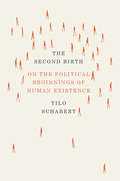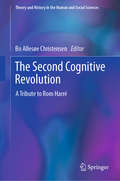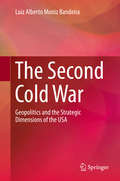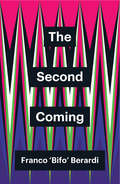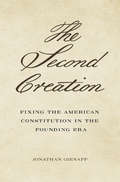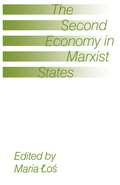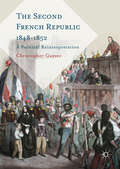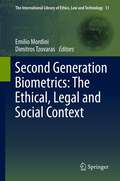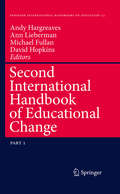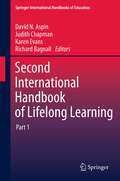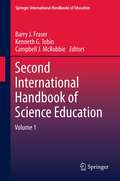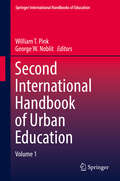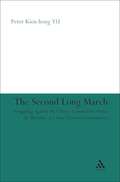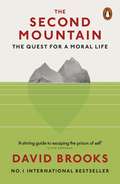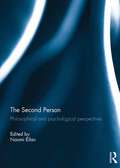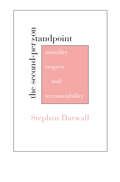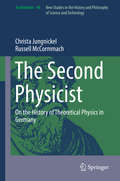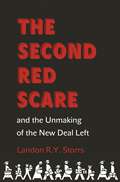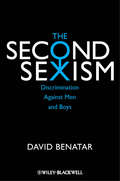- Table View
- List View
The Second Birth: On the Political Beginnings of Human Existence
by Tilo SchabertMost scholars link the origin of politics to the formation of human societies, but in this innovative work, Tilo Schabert takes it even further back: to our very births. Drawing on mythical, philosophical, religious, and political thought from around the globe—including America, Europe, the Middle East, and China—The Second Birth proposes a transhistorical and transcultural theory of politics rooted in political cosmology. With impressive erudition, Schabert explores the physical fundamentals of political life, unveiling a profound new insight: our bodies actually teach us politics. Schabert traces different figurations of power inherent to our singular existence, things such as numbers, time, thought, and desire, showing how they render our lives political ones—and, thus, how politics exists in us individually, long before it plays a role in the establishment of societies and institutions. Through these figurations of power, Schabert argues, we learn how to institute our own government within the political forces that already surround us—to create our own world within the one into which we have been born. In a stunning vision of human agency, this book ultimately sketches a political cosmos in which we are all builders, in which we can be at once political and free.
The Second Birth: On the Political Beginnings of Human Existence
by Tilo SchabertMost scholars link the origin of politics to the formation of human societies, but in this innovative work, Tilo Schabert takes it even further back: to our very births. Drawing on mythical, philosophical, religious, and political thought from around the globe—including America, Europe, the Middle East, and China—The Second Birth proposes a transhistorical and transcultural theory of politics rooted in political cosmology. With impressive erudition, Schabert explores the physical fundamentals of political life, unveiling a profound new insight: our bodies actually teach us politics. Schabert traces different figurations of power inherent to our singular existence, things such as numbers, time, thought, and desire, showing how they render our lives political ones—and, thus, how politics exists in us individually, long before it plays a role in the establishment of societies and institutions. Through these figurations of power, Schabert argues, we learn how to institute our own government within the political forces that already surround us—to create our own world within the one into which we have been born. In a stunning vision of human agency, this book ultimately sketches a political cosmos in which we are all builders, in which we can be at once political and free.
The Second Birth: On the Political Beginnings of Human Existence
by Tilo SchabertMost scholars link the origin of politics to the formation of human societies, but in this innovative work, Tilo Schabert takes it even further back: to our very births. Drawing on mythical, philosophical, religious, and political thought from around the globe—including America, Europe, the Middle East, and China—The Second Birth proposes a transhistorical and transcultural theory of politics rooted in political cosmology. With impressive erudition, Schabert explores the physical fundamentals of political life, unveiling a profound new insight: our bodies actually teach us politics. Schabert traces different figurations of power inherent to our singular existence, things such as numbers, time, thought, and desire, showing how they render our lives political ones—and, thus, how politics exists in us individually, long before it plays a role in the establishment of societies and institutions. Through these figurations of power, Schabert argues, we learn how to institute our own government within the political forces that already surround us—to create our own world within the one into which we have been born. In a stunning vision of human agency, this book ultimately sketches a political cosmos in which we are all builders, in which we can be at once political and free.
The Second Birth: On the Political Beginnings of Human Existence
by Tilo SchabertMost scholars link the origin of politics to the formation of human societies, but in this innovative work, Tilo Schabert takes it even further back: to our very births. Drawing on mythical, philosophical, religious, and political thought from around the globe—including America, Europe, the Middle East, and China—The Second Birth proposes a transhistorical and transcultural theory of politics rooted in political cosmology. With impressive erudition, Schabert explores the physical fundamentals of political life, unveiling a profound new insight: our bodies actually teach us politics. Schabert traces different figurations of power inherent to our singular existence, things such as numbers, time, thought, and desire, showing how they render our lives political ones—and, thus, how politics exists in us individually, long before it plays a role in the establishment of societies and institutions. Through these figurations of power, Schabert argues, we learn how to institute our own government within the political forces that already surround us—to create our own world within the one into which we have been born. In a stunning vision of human agency, this book ultimately sketches a political cosmos in which we are all builders, in which we can be at once political and free.
The Second Cognitive Revolution: A Tribute to Rom Harré (Theory and History in the Human and Social Sciences)
by Bo Allesøe ChristensenRom Harré’s career spans more than 40 years of original contributions to the development of both psychology and other human and social sciences. Recognized as a founder of modern social psychology, he developed the microsociological approach ‘ethogenics’ and facilitated the discursive turn within psychology, as well as developed the concept of positioning theory. Used within both philosophy and social scientific approaches aimed at conflict analysis, analyses of power relations, and narrative structures, the development and impact of positioning theory can be understood as part of a second cognitive revolution. Whereas the first cognitive revolution involved incorporating cognition as both thoughts and feelings as an ineliminable part of psychology and social sciences, this second revolution released this cognition from a focus on individuals, and towards a focus of understanding individuals as participating in public practices using public discourses as part of their cognition. This edited volume adds to the scholarly conversation around positioning theory, evaluates Rom Harré’s significance for the history and development of psychology, and highlights his numerous theoretical contributions and their lasting effects on the psychological and social sciences.Included among the chapters:What is it to be a human being? Rom Harré on self and identityThe social philosophy of Harré as a philosophy of cultureThe discursive ontology of the social worldEthics in socio-cultural psychologiesDiscursive cognition and neural networksThe Second Cognitive Revolution: A Tribute to Rom Harré is an indispensable reader for anyone interested in his cognitive-historical turn, and finds an audience with academics and researchers in the social and human science fields of cognitive psychology, social psychology, discursive psychology, philosophy, sociology, and ethnomethodology.
The Second Cold War: Geopolitics and the Strategic Dimensions of the USA
by Luiz Alberto Moniz BandeiraThis book investigates the geopolitics and strategic dimensions of US-American foreign policy during George W. Bush's and Barack Obama's presidential terms. Based on a vast amount of empirical and historical sources, the author offers deep insights into the recent political developments ('Arabellions') along the axis of Northern Africa, the Middle East, and Central Asia, situating them in the context of the global geopolitical and geo-economical Great Game, either latent or overt, between USA/NATO and Russia. The author also analyses the influence of the US on these historical and political processes in the last two decades.
The Second Coming (Theory Redux)
by Franco BerardiWe have entered the gateway to the apocalypse. This theological concept is the best metaphor to describe the world in which we are already living. Chaos is all around us: political folly, economical delirium, ecological catastrophe, intellectual cynicism, technological simulation of life. This is what Franco ‘Bifo’ Berardi suggests in this wry, dark, disconcerting but also brilliant and invigorating journey through the main events that we have witnessed in recent years. One century after the Communist revolution, the very idea that the world could be changed for the better seems dead once and for all. Every time that a new change occurs nowadays, it seems to be a change for the worse. But the fact that nothing can save us any more shouldn’t be seen as a form of fatality or a reason for surrender. On the contrary, if our world is dead, then the space is open for another to appear – a world where apocalypse can shake us out of our zombie-like contemporary existence. The second coming of Communism will have nothing to do with 1917. Apocalypse has to be conceived of as a metaphor, and Communism is a metaphor too: the metaphor of the possible deployment of the potentials of the mind.
The Second Creation: Fixing the American Constitution in the Founding Era
by Jonathan GienappAmericans widely believe that the U.S. Constitution was almost wholly created when it was drafted in 1787 and ratified in 1788. Jonathan Gienapp recovers the unknown story of the Constitution’s second creation in the decade after its adoption—a story with explosive implications for current debates over constitutional originalism and interpretation.
The Second Economy in Marxist States
by Maria LosThis book analyses and compares the unofficial economies and their control in ten marxist states: the USSR, Poland, Hungary, Romania, Yugoslavia, Cuba, Nicaragua, China, Angola and Tanzania. It provides a vivid, mosaic-like panorama of the hidden economies in these countries. The book breaks with the view that the unofficial economy is simply a by-product of the official economy. It shows an unfolding interplay between these two economies, which moulds and limits both the dynamics and the direction of the process of change. In her final essay, Maria Los develops a theoretical model linking second economies with the process of marxist economic development. The key stages of this process are identified as: (1) The stage of radical transformation; (2) The monopolisation period; (3) The reformist phase; and (4) Post- reformist decadence. The volume throws a new light on the prospects and problems of the reformist movements which have swept the Soviet Union, China and several other marxist states in the 1980s.
The Second French Republic 1848-1852: A Political Reinterpretation
by Christopher GuyverThis book follows the story of the Second French Republic from its idealistic beginnings in February 1848 to its formal replacement in December 1852 by the Second Empire. Based on original archival research, The Second French Republic gives a detailed account of the internal tensions that irrevocably weakened France’s shortest republic. During this short period French political life was buffeted by strong and often contrary forces: universal manhood suffrage, fear of socialism, the President Louis-Napoleon Bonaparte, and the political ambitions of the military high command for the restoration of the monarchy.
Second Generation Biometrics: The Ethical, Legal and Social Context (The International Library of Ethics, Law and Technology #11)
by Emilio Mordini and Dimitros TzovarasWhile a sharp debate is emerging about whether conventional biometric technology offers society any significant advantages over other forms of identification, and whether it constitutes a threat to privacy, technology is rapidly progressing. Politicians and the public are still discussing fingerprinting and iris scan, while scientists and engineers are already testing futuristic solutions. Second generation biometrics - which include multimodal biometrics, behavioural biometrics, dynamic face recognition, EEG and ECG biometrics, remote iris recognition, and other, still more astonishing, applications – is a reality which promises to overturn any current ethical standard about human identification. Robots which recognise their masters, CCTV which detects intentions, voice responders which analyse emotions: these are only a few applications in progress to be developed.This book is the first ever published on ethical, social and privacy implications of second generation biometrics. Authors include both distinguished scientists in the biometric field and prominent ethical, privacy and social scholars. This makes this book an invaluable tool for policy makers, technologists, social scientists, privacy authorities involved in biometric policy setting. Moreover it is a precious instrument to update scholars from different disciplines who are interested in biometrics and its wider social, ethical and political implications.
Second International Handbook of Educational Change (Springer International Handbooks of Education #23)
by David Hopkins Andy Hargreaves Michael Fullan Ann LiebermanThe two volumes of the second edition of the International Handbook of Educational Change comprise a totally new, and updated collection of the most critical and cutting-edge ideas in educational change. Written by the most influential thinkers in the field, these volumes cover educational change at both the theoretical and practical levels. The updated handbook remains connected to the classical concerns of the field, such as educational innovation, reform, and change management, and also offers new insights into educational change that have been brought about by social change and shifting contexts of educational reform. Like the first best selling Handbook, this one will also undoubtedly become an essential resource for people involved in all spheres of education, from classroom teachers, teacher leaders and administrators to educational researchers, curriculum developers, and university professors. No other work provides such a wide-ranging and comprehensive examination of the field of educational change.
Second International Handbook of Lifelong Learning (Springer International Handbooks of Education #26)
by David N. Aspin, Judith Chapman, Karen Evans and Richard BagnallThe second edition of the International Handbook of Lifelong Learning is extensive, innovative, and international in scope, remit and vision, inviting its readers to engage in a critical re-appraisal of the theme of “lifelong learning”. It is a thorough-going, rigorous and scholarly work, with profound and wide-ranging implications for the future of educating institutions and agencies of all kinds in the conception, planning and delivery of lifelong learning initiatives. Lifelong learning requires a wholly new philosophy of learning, education and training, one that aims to facilitate a coherent set of links and pathways between work, school and education, and recognises the necessity for government to give incentives to industry and their employees so they can truly “invest” in lifelong learning. It is also a concept that is premised on the understanding of a learning society in which everyone, independent of race, creed or gender, is entitled to quality learning that is truly excellent.This book recognises the need for profound changes in education and for goals that are critically important to education, economic advancement, and social involvement. To those concerned about the future of our society, our economy and educational provision, this book provides a richly illuminating basis for powerful debate. Drawing extensively on policy analyses, conceptual thinking and examples of informed and world-standard practice in lifelong learning endeavours in the field, both editors and authors seek to focus readers' attention on the many issues and decisions that must be addressed if lifelong learning is to become a reality for us all.
Second International Handbook of Science Education (Springer International Handbooks of Education #24)
by Barry J. Fraser, Kenneth Tobin and Campbell J. McRobbieThe International Handbook of Science Education is a two volume edition pertaining to the most significant issues in science education. It is a follow-up to the first Handbook, published in 1998, which is seen as the most authoritative resource ever produced in science education. The chapters in this edition are reviews of research in science education and retain the strong international flavor of the project. It covers the diverse theories and methods that have been a foundation for science education and continue to characterize this field.Each section contains a lead chapter that provides an overview and synthesis of the field and related chapters that provide a narrower focus on research and current thinking on the key issues in that field. Leading researchers from around the world have participated as authors and consultants to produce a resource that is comprehensive, detailed and up to date. The chapters provide the most recent and advanced thinking in science education making the Handbook again the most authoritative resource in science education.
Second International Handbook of Urban Education (Springer International Handbooks of Education)
by William T. Pink George W. NoblitThis second handbook offers all new content in which readers will find a thoughtful and measured interrogation of significant contemporary thinking and practice in urban education. Each chapter reflects contemporary cutting-edge issues in urban education as defined by their local context. One important theme that runs throughout this handbook is how urban is defined, and under what conditions the marginalized are served by the schools they attend. Schooling continues to hold a special place both as a means to achieve social mobility and as a mechanism for supporting the economy of nations. This second handbook focuses on factors such as social stratification, segmentation, segregation, racialization, urbanization, class formation and maintenance, and patriarchy. The central concern is to explore how equity plays out for those traditionally marginalized in urban schools in different locations around the globe. Researchers will find an analysis framework that will make the current practice and outcomes of urban education, and their alternatives, more transparent, and in turn this will lead to solutions that can help improve the life-options for students historically underserved by urban schools.
The Second Long March: Struggling Against the Chinese Communists Under the Republic of China (Taiwan) Constitution
by Peter Kien-Hong YUThis work, written by an expert in the politics of Mainland China and Taiwan, looks at the role the Constitution of the Republic of China has played in the development of Taiwan since 1949 and its potential influence on the People's Republic of China.The Chinese Communists conducted the first long march for the sake of the majority of Chinese people, with the victory of MAO Zedong. In the second long march, CHIANG Kai-shek and his successors tried to convert the Chinese mainland from a Communist, totalitarian system, into a democratic, prosperous one by relying on the spirit of the Republic of China (ROC) constitution and by setting itself as a good example, in gradually guaranteeing freedom and democracy. Needless to say, this march is long and difficult. The Second Long March challenges other models and theories on the study of the relationship between the ROC (Taiwan area) and mainland China or the People's Republic of China (PRC) since China became politically (as opposed to legally) divided in December 1949. Arguably, it is the ROC Constitution that has helped ROC citizens to live in a non-Communist or anti-Communist political system. Actively promoting democracy and freedom on the Chinese mainland (neidi) can further guarantee the Taiwan area's survival. The book will provide valuable scholarship of interest to anyone researching the political history of China and its prospects for democratization.
The Second Mountain: The Quest for a Moral Life
by David BrooksNO.1 BESTSELLING AUTHOR OF THE SOCIAL ANIMALAre you on your first or second mountain? Is life about you - or others? About success - or something deeper? The world tells us that we should pursue our self-interest: career wins, high status, nice things. These are the goals of our first mountain. But at some point in our lives we might find that we're not interested in what other people tell us to want. We want the things that are truly worth wanting.This is the second mountain. What does it mean to look beyond yourself and find a moral cause? To forget about independence and discover dependence - to be utterly enmeshed in a web of warm relationships? What does it mean to value intimacy, devotion, responsibility and commitment above individual freedom? In The Second Mountain David Brooks explores the meaning and possibilities that scaling a second mountain offer us and the four commitments that most commonly move us there: family, vocation, philosophy and community. Inspiring, personal and full of joy, this book will help you discover why you were really put on this earth.
The Second Person: Philosophical and Psychological Perspectives
by Naomi EilanThe past few years have witnessed an exponentially growing body of work conducted under the ‘second person’ heading. This idea has been explored in various areas of philosophy (philosophy of mind, philosophy of language, ethics, epistemology), in developmental psychology, in psychiatry, and even in neuroscience. We may call this interest in the second person the ‘You Turn’. To put it at its most general, and ambitious, the idea driving much of the work is this: proper attention to the ways in which we relate to one another when we stand in second person relation to each other can deliver something like a paradigm shift in the way in which we address questions about a range of fundamental issues in these fields. There is, however, very little agreement about what second person relations are, and a huge variation in why people think they are important. The contributions to this book focus on developing key second-person claims in the philosophy of mind, ethics and epistemology, with the aim of beginning to provide a framework for assessing and relating the multitude of fascinating new questions that come up under the second person heading.This book was originally published as a special issue of Philosophical Explorations.
The Second Person: Philosophical and Psychological Perspectives
by Naomi EilanThe past few years have witnessed an exponentially growing body of work conducted under the ‘second person’ heading. This idea has been explored in various areas of philosophy (philosophy of mind, philosophy of language, ethics, epistemology), in developmental psychology, in psychiatry, and even in neuroscience. We may call this interest in the second person the ‘You Turn’. To put it at its most general, and ambitious, the idea driving much of the work is this: proper attention to the ways in which we relate to one another when we stand in second person relation to each other can deliver something like a paradigm shift in the way in which we address questions about a range of fundamental issues in these fields. There is, however, very little agreement about what second person relations are, and a huge variation in why people think they are important. The contributions to this book focus on developing key second-person claims in the philosophy of mind, ethics and epistemology, with the aim of beginning to provide a framework for assessing and relating the multitude of fascinating new questions that come up under the second person heading.This book was originally published as a special issue of Philosophical Explorations.
The Second-Person Standpoint: Morality, Respect, and Accountability
by Stephen DarwallWhy should we avoid doing moral wrong? The inability of philosophy to answer this question in a compelling manner—along with the moral skepticism and ethical confusion that ensue—result, Stephen Darwall argues, from our failure to appreciate the essentially interpersonal character of moral obligation. After showing how attempts to vindicate morality have tended to change the subject—falling back on non-moral values or practical, first-person considerations—Darwall elaborates the interpersonal nature of moral obligations: their inherent link to our responsibilities to one another as members of the moral community. As Darwall defines it, the concept of moral obligation has an irreducibly second-person aspect; it presupposes our authority to make claims and demands on one another. And so too do many other central notions, including those of rights, the dignity of and respect for persons, and the very concept of person itself. The result is nothing less than a fundamental reorientation of moral theory that enables it at last to account for morality’s supreme authority—an account that Darwall carries from the realm of theory to the practical world of second-person attitudes, emotions, and actions.
The Second Physicist: On the History of Theoretical Physics in Germany (Archimedes #48)
by Christa Jungnickel Russell McCormmachThis book explores the rise of theoretical physics in 19th century Germany. The authors show how the junior second physicist in German universities over time became the theoretical physicist, of equal standing to the experimental physicist. Gustav Kirchhoff, Hermann von Helmholtz, and Max Planck are among the great German theoretical physicists whose work and career are examined in this book.Physics was then the only natural science in which theoretical work developed into a major teaching and research specialty in its own right. Readers will discover how German physicists arrived at a well-defined field of theoretical physics with well understood and generally accepted goals and needs. The authors explain the nature of the work of theoretical physics with many examples, taking care always to locate the research within the workplace.The book is a revised and shortened version of Intellectual Mastery of Nature: Theoretical Physics from Ohm to Einstein, a two-volume work by the same authors. This new edition represents a reformulation of the larger work. It retains what is most important in the original work, while including new material, sharpening discussions, and making the research more accessible to readers. It presents a thorough examination of a seminal era in physics.
The Second Red Scare and the Unmaking of the New Deal Left
by Landon R.Y. StorrsIn the name of protecting Americans from Soviet espionage, the post-1945 Red Scare curtailed the reform agenda of the New Deal. The crisis of the Great Depression had brought into government a group of policy experts who argued that saving democracy required attacking economic and social inequalities. The influence of these men and women within the Franklin D. Roosevelt administration, and their alliances with progressive social movements, elicited a powerful reaction from conservatives, who accused them of being subversives. Landon Storrs draws on newly declassified records of the federal employee loyalty program—created in response to claims that Communists were infiltrating the U.S. government—to reveal how disloyalty charges were used to silence these New Dealers and discredit their policies. Because loyalty investigators rarely distinguished between Communists and other leftists, many noncommunist leftists were forced to leave government or deny their political views. Storrs finds that loyalty defendants were more numerous at higher ranks of the civil service than previously thought, and that many were women, or men with accomplished leftist wives. Uncovering a forceful left-feminist presence in the New Deal, she also shows how opponents on the Right exploited popular hostility to powerful women and their supposedly effeminate spouses. The loyalty program not only destroyed many promising careers, it prohibited discussion of social democratic policy ideas in government circles, narrowing the scope of political discourse to this day. Through a gripping narrative based on remarkable new sources, Storrs demonstrates how the Second Red Scare repressed political debate and constrained U.S. policymaking in fields such as public assistance, national health insurance, labor and consumer protection, civil rights, and international aid.
The Second Red Scare and the Unmaking of the New Deal Left
by Landon R.Y. StorrsIn the name of protecting Americans from Soviet espionage, the post-1945 Red Scare curtailed the reform agenda of the New Deal. The crisis of the Great Depression had brought into government a group of policy experts who argued that saving democracy required attacking economic and social inequalities. The influence of these men and women within the Franklin D. Roosevelt administration, and their alliances with progressive social movements, elicited a powerful reaction from conservatives, who accused them of being subversives. Landon Storrs draws on newly declassified records of the federal employee loyalty program—created in response to claims that Communists were infiltrating the U.S. government—to reveal how disloyalty charges were used to silence these New Dealers and discredit their policies. Because loyalty investigators rarely distinguished between Communists and other leftists, many noncommunist leftists were forced to leave government or deny their political views. Storrs finds that loyalty defendants were more numerous at higher ranks of the civil service than previously thought, and that many were women, or men with accomplished leftist wives. Uncovering a forceful left-feminist presence in the New Deal, she also shows how opponents on the Right exploited popular hostility to powerful women and their supposedly effeminate spouses. The loyalty program not only destroyed many promising careers, it prohibited discussion of social democratic policy ideas in government circles, narrowing the scope of political discourse to this day. Through a gripping narrative based on remarkable new sources, Storrs demonstrates how the Second Red Scare repressed political debate and constrained U.S. policymaking in fields such as public assistance, national health insurance, labor and consumer protection, civil rights, and international aid.
The Second Sexism: Discrimination Against Men and Boys (Blackwell Public Philosophy Ser.)
by David BenatarDoes sexism against men exist? What it looks like and why we need to take it seriously This book draws attention to the "second sexism," where it exists, how it works and what it looks like, and responds to those who would deny that it exists. Challenging conventional ways of thinking, it examines controversial issues such as sex-based affirmative action, gender roles, and charges of anti-feminism. The book offers an academically rigorous argument in an accessible style, including the careful use of empirical data, and includes examples and engages in a discussion of how sex discrimination against men and boys also undermines the cause for female equality.
The Second Sexism: Discrimination Against Men and Boys
by David BenatarDoes sexism against men exist? What it looks like and why we need to take it seriously This book draws attention to the "second sexism," where it exists, how it works and what it looks like, and responds to those who would deny that it exists. Challenging conventional ways of thinking, it examines controversial issues such as sex-based affirmative action, gender roles, and charges of anti-feminism. The book offers an academically rigorous argument in an accessible style, including the careful use of empirical data, and includes examples and engages in a discussion of how sex discrimination against men and boys also undermines the cause for female equality.
